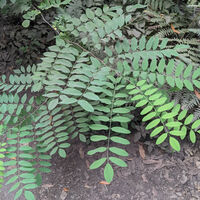black locust
Robinia pseudoacacia
Member of
locust trees (genus Robinia)
legume family (family Fabaceae)
dicots (class Magnoliopsida)
white in flowering plants
Except for extremely rare examples that I don't expect to encounter, there are no other wild species of this genus in the bay area.


The black locust (Robinia pseudoacacia) generally has spines at the base of the leaf, although some cultivars lack the spines. Compare to california false indigo (Amorpha californica), which doesn’t have spines at the base of the leaf but does have prickle-like glands along the leaf midrib.
Edibility: Eating seeds, leaves, or bark may be fatal to humans and livestock. [source]
Toxicity of acacia, black; acacia, false; locust, black or yellow (Robinia pseudoacacia):
4 – Ingestion of these plants, especially in large amounts, is expected to cause serious effects to the heart, liver, kidneys or brain. If ingested in any amount, call the poison center immediately.
Locations: Months: For more details, use advanced search.
Chris’s observations: 2 (1 is research grade)
Taxon info: iNaturalist – Calflora – CalPhotos – Jepson eFlora – FNA
Bay Area species: iNaturalist – Calflora